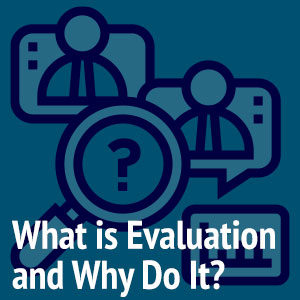
Evaluation is not just useful for measuring the final outcomes of programs and initiatives, it can also help program designers, managers, and implementers to understand if a program is achieving its goals and delivering the services to those the program is intended to assist. In fact, one of the key benefits of conducting an evaluation is that early monitoring of an initiative can help document which services and program elements beneficiaries are getting. It can also provide timely information to program implementers that will allow them to adjust and address challenges to the program. “Although the terms “monitoring and evaluation” tend to get run together as if they are only one thing, monitoring and evaluation are, in fact, two distinct sets of organizational activities… Monitoring is the periodic assessment of programmed activities to determine whether they are proceeding as planned. Monitoring is the continuous and systematic assessment of project implementation based on targets set and activities planned during the planning phases of the work.” (See “Monitoring and Evaluation: Definition, Process, Objectives” Differences)
“High-quality monitoring…encourages timely decision-making, ensures project accountability, and provides a robust foundation for evaluation and learning. It is through the continuous monitoring of project performance that you have an opportunity to learn about what is working well and what challenges are arising.” (See, Chapter 10: Monitoring and Evaluation (M&E) A Guide, Catholic Relief Services)
Program monitoring is similar to process evaluation. The CDC, for example, observes that process evaluation strives to assess: 1) how well the program is working in its early stages and throughout implementation, 2) the extent to which the program is being implemented as designed, and 3) whether the program is accessible and acceptable to its target population (See “Types of Program Evaluation” ). The CDC further observes that a process evaluation is useful because it “provides an early warning for any problems that may occur and allows programs to monitor how well their program plans and activities are working.” Process evaluations can be implemented along with outcome evaluations, the latter aim to show the ultimate effect on intended recipients. (For more information on the different kinds of evaluations, see our article “Understanding Different Types of Program Evaluations.” )
“Process evaluations aim to explain how complex interventions work. They are especially useful for interventions that include a number of interacting components operating in different ways and also when interventions address complex problems, or seek to generate multiple outcomes. Process evaluations can be independent studies or conducted simultaneously with outcome evaluations, such as randomized controlled trials. They examine the processes through which an intervention generates outcomes, that is, how they work.”(See “Process Evaluation” — UK Government )
Whether termed “process evaluation” or “program monitoring”, early and continuing efforts to gather information about the implementation of a program can play a critical role both in refining the program and ensuring the likelihood of its success.
Resources:
“Monitoring and Evaluation: Definition, Process, Objectives”
Chapter 10: Monitoring and Evaluation (M&E) A Guide, Catholic Relief Services
Monitoring and Evaluation – Post COVID19 Complete Guide
“Types of Program Evaluation,” CDC
“Process Evaluation” — UK Government





